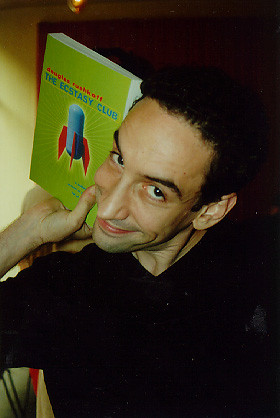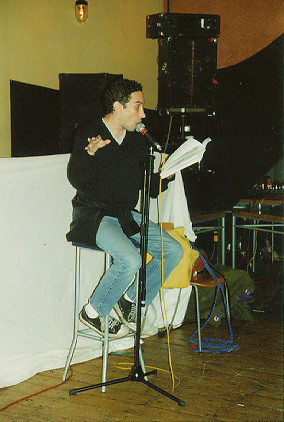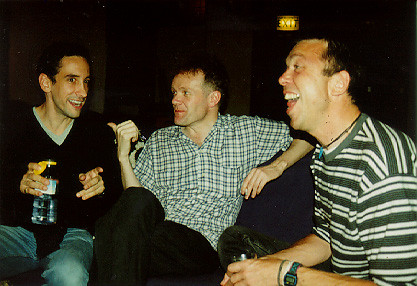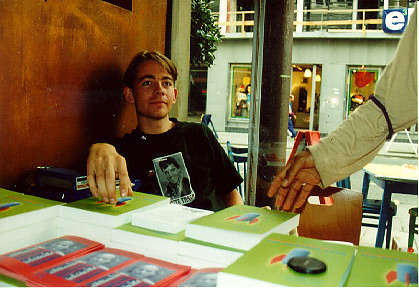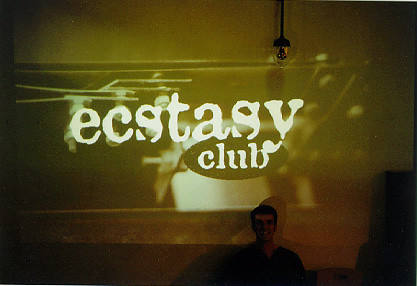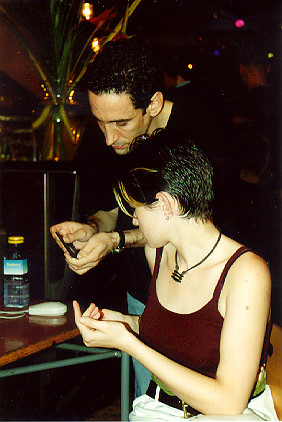This one is old, yes. And it’s LONG since I’m publishing an entire letter of reference that Doug gave me for Uni (the project was my MA final project). But I unearthed it recently and it was a project that no one knows about because it was right at the start of my geek arts career, so I want to share it in its entirety. Other testimonials are here.
I’m still not quite sure how I managed to stumble in to this one, but, incredibly, the project was a collaboration with the truly inspirational Douglas Rushkoff, who last year hosted ContactCon in NYC.
You can still see very broken remnants of the old old site (my first HTML site ever!) via way back machine. Here’s a link to the book that I brought to life. And here’s what he said about our collaboration back in 1997… *grin*
Subject: Ecstasy Club Post-game Show
Date: Tue, 9 Sep 1997
Hi Fee,
Here’s a letter to the advisors on the project, and whoever else you might want it for.
love love
Douglas
===============
Dear Professor,
Fee’s realization of The Ecstasy Club was at once an amplification of the book’s themes, a test of its characterizations, an extension of its central metaphors into the world at large, and a media prank in the spirit of the book’s main purpose. I loved it.
Last Winter, Fee presented me with the possibility of creating a multimedia project based on the book. I jumped at the chance. Ecstasy Club is about a youthful quest for time travel amongst some idealist young people in San Francisco, California. After moving into an abandoned warehouse, they realize that maintaining their group identity will require them to form something much like a cult. As they fold deeper into their own crease in the cultural fabric, they find themselves becoming increasingly paranoid about the forces around them — especially the media.
After a series of adventures in psychedelic and cyberdelic spaces, they believe they have stumbled upon a means of true time travel; but they find they are not alone in their journeys. A giant, multinational corporation and religion called Cosmotology appears to be exploiting the same technology — but for the opposite purpose. Instead of hoping to liberate culture, the corporation and its leader hope to dominate it.
Ultimately, the book’s main character and narrator “realizes” that the time travel itself is a sham. The real methods of time travel being exploited are simply hype and spin. If one can sufficiently hype an event before it happens, he can successfully create or change the future. If one can “spin” history with enough authority, he can literally “change” the past. The battle between the Ecstasy Club and Cosmotology becomes a battle of hype and spin in the media, and in their own minds.
By the end of the book, as the two cults merge, it is uncertain exactly who has been co-opted by whom.
Such was the intent of Fee’s web site and Ecstasy Club event. The site was to seem as if it were created by a real Estasy Club — the very club on which the “fictional” book was based. And the club is mad. They accuse Douglas Rushkoff of not really being the author of the book, but rather a stand-in for the narrator, who really was a member of the club and went insane after taking too many drugs.
They list their real names, occupations, and concerns, as well as plans for legal proceedings against Rushkoff and his publisher.
Initial response to the site was startling. Several people rushed to my defense, while others seemed shocked and upset to learn that a nice rave club had been exploited by a publisher. Still others claimed that the Ecstasy Club in the site was not the club on which the book was based; no, they knew the “real” club, and its real members.
The site extended the confusion I had hoped to create with the original text. The book is constructed to make the reader believe he knows the people and institutions on which the story is based. This way, as the reader tries to connect fact and fiction, he falls into the same trap as the paranoid characters: he draws too many connections and envisions a conspiracy. By pushing the story out into the “real world,” Fee brought people into another level of confusion and suspicion. So much so, that they actually believed the book was based on a real group of people.
Then came the real kicker. Fee decided to create an event, “Potential Futures” (based on the initials of every Ecstasy Club party in the book — Phylogenic Foresight, Pandora’s Fix, Piano Factory, etc) where the real Ecstasy Club could celebrate its existence, and protest the publication of the libelous book.
But the publisher of the book — the real life publisher, mind you — decided that if Douglas Rushkoff was actually going to appear at this event on their billing sheet, books would have to be sold there. This would present quite a problem for the plot of the evening.
This is where Fee came through in an amazing way: She staged a reconciliation between me and Duncan, the leader of the club from within the story of the book. We simply shook hands, announced that I was now a member of the club, and that the Ecstasy Club was now supporting my publication efforts.
It was left up to the audience and press in attendance (including the BBC2 radio people) to decide whether I had been co-opted by the club, or the club by me. Like the book, the event settled nothing.
But the evening and preceding afternoon of multimedia work exposed the audience to some breathtaking multimedia work, all created to generate the illusion that a real club, just like the one depicted in the book, actually existed. In fact, it’s hard to say where the fiction begins or ends.
Fee’s DJ’s have actually taken the names of characters in the book — the Nexus Twins. They created a song and rock video depicting scenes that were in the book. In their recreation for the camera, the scenes actually occurred — so are they real or not?
Another installation allowed the audience to point and click their way through an architectural and conceptual map of the club. It wasn’t really a floorplan, yet it wasn’t as random as a thought map. It isolated visual, thematic, and stylistic elements of different places and moments in the book, and let the user wander through them, read text, and “experience” the technoshamanic visionquest machine central to the time travel in the story.
Elsewhere in the space, a artist created an abstract interpretation of the club on a giant canvas, archetypic Charlie Chaplain movies plain in almost digital slow motion, and giant paintings of images from the book — like the tattoo of a fetus — adorned the walls.
Email I received after the event ran the gamut from fans glad that I had reconciled with my enemies to reporters asking if the lawsuit was still in effect. A few of the more media savvy conceptual artists wrote simply to congratulate me and Fee on a performance well done.
Without exception, Fee and the people helping her had a deep understanding of the book I wrote and the ways to express its essence into other media and live performance. This was the first genuine electronic and live action Situationist-type event I have ever experienced that actually worked.
Most surprisingly, it seems as though the original intent of the characters in the book — an earnest yearning for real human connection through music and technology — was realized in Manchester that night. Fee graduated my characters and, in some ways, me, from distanced cyncism into live celebration. I don’t think she was content with my characters’ failure to achieve anything approaching a real harmony, and showed this non-believer that by pushing through the hype and spin — or even just accepting it as a natural part of the mediaspace — we can find something brighter on the other side. I encourage you to support her work in any way you can. I know I will.
sincerely yours,
Douglas Rushkoff
author, The Ecstasy Club

